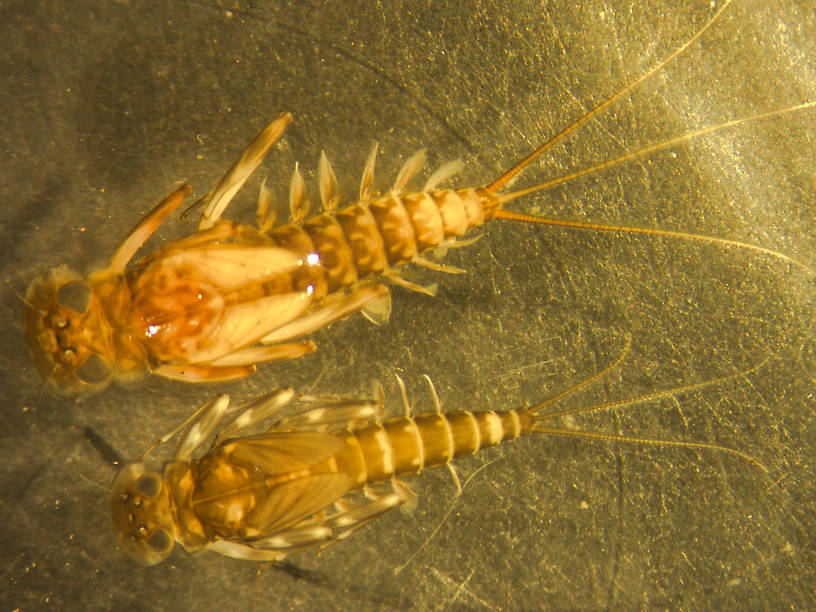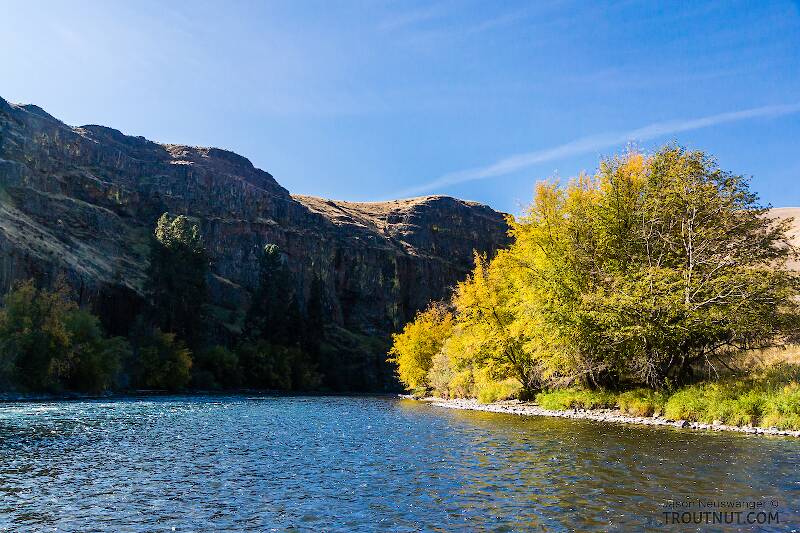
Salmonflies
Pteronarcys californica
The giant Salmonflies of the Western mountains are legendary for their proclivity to elicit consistent dry-fly action and ferocious strikes.
Featured on the forum

This is a striking caddis larva with an interesting color pattern on the head. Here are some characteristics I was able to see under the microscope, but could not easily expose for a picture:
- The prosternal horn is present.
- The mandible is clearly toothed, not formed into a uniform scraper blade.
- The seems to be only 2 major setae on the ventral edge of the hind femur.
- Chloride epithelia seem to be absent from the dorsal side of any abdominal segments.
Based on these characteristics and the ones more easily visible from the pictures, this seems to be Grammotaulius. The key's description of the case is spot-on: "Case cylindrical, made of longitudinally arranged sedge or similar leaves," as is the description of the markings on the head, "Dorsum of head light brownish yellow with numerous discrete, small, dark spots." The spot pattern on the head is a very good match to figure 19.312 of Merritt R.W., Cummins, K.W., and Berg, M.B. (2019). The species ID is based on Grammotaulius betteni being the only species of this genus known in Washington state.
- The prosternal horn is present.
- The mandible is clearly toothed, not formed into a uniform scraper blade.
- The seems to be only 2 major setae on the ventral edge of the hind femur.
- Chloride epithelia seem to be absent from the dorsal side of any abdominal segments.
Based on these characteristics and the ones more easily visible from the pictures, this seems to be Grammotaulius. The key's description of the case is spot-on: "Case cylindrical, made of longitudinally arranged sedge or similar leaves," as is the description of the markings on the head, "Dorsum of head light brownish yellow with numerous discrete, small, dark spots." The spot pattern on the head is a very good match to figure 19.312 of Merritt R.W., Cummins, K.W., and Berg, M.B. (2019). The species ID is based on Grammotaulius betteni being the only species of this genus known in Washington state.

Troutnut is a project started in 2003 by salmonid ecologist Jason "Troutnut" Neuswanger to help anglers and
fly tyers unabashedly embrace the entomological side of the sport. Learn more about Troutnut or
support the project for an enhanced experience here.
Ecdyonurus criddlei (Little Slate-Winged Dun) Mayfly Nymph Pictures
This is an interesting Heptageniid mayfly since in western Montana it is only found in cold lakes, especially those in Glacier National Park.

This mayfly was collected from Kintla Lake in Montana on July 31st, 2007 and added to Troutnut.com by Bnewell on June 26th, 2011.
Discussions of this Nymph
Ecdyonurus nymphs
Posted by Jmw975 on Dec 11, 2012
Last reply on Dec 11, 2012 by Jmw975
Hi all,
These specimens are in great shape!
the lower nymph in this photo is definitely not E. criddlei, but E. simplicoides. E. simplicioides has that distinctive color pattern with the pair of rectangular pale markings on tergum 4 and no median markings on the other terga.
The upper specimen is probably E. criddlei, but seems to have more extensive pale markings than specimens from further west.
cheers,
Jeff
These specimens are in great shape!
the lower nymph in this photo is definitely not E. criddlei, but E. simplicoides. E. simplicioides has that distinctive color pattern with the pair of rectangular pale markings on tergum 4 and no median markings on the other terga.
The upper specimen is probably E. criddlei, but seems to have more extensive pale markings than specimens from further west.
cheers,
Jeff
Start a Discussion of Nymph
References
- Merritt R.W., Cummins, K.W., and Berg, M.B. 2019. An Introduction to the Aquatic Insects of North America (Fifth Edition). Kendall/Hunt Publishing Company.

